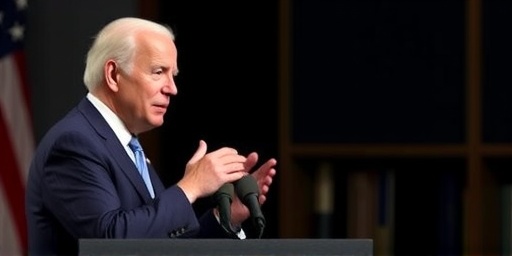In a flurry of activity just weeks before handing over the reins to President-elect Donald Trump, outgoing President Joe Biden signed a series of executive orders targeting climate protection and immigration reforms. These moves, executed on January 15, 2025, are designed to embed progressive policies into the federal framework, anticipating swift rollbacks by the incoming administration. Sources close to the White House describe the actions as a strategic bulwark against anticipated deregulatory efforts, while Republican leaders decry them as an overreach by a lame-duck president.
The executive orders, numbering five in total, focus primarily on bolstering environmental regulations and streamlining certain immigration pathways. Biden‘s team emphasized the urgency, citing ongoing climate crises and humanitarian needs at the border. ‘These are not partisan plays; they’re about safeguarding America’s future,’ a senior administration official told reporters during a briefing. With the presidential transition underway, these orders highlight the tense handover between two starkly different visions for the nation.
Biden‘s Climate Directives: Cementing Green Policies Amid Looming Threats
At the heart of Biden’s final executive actions are three orders centered on climate initiatives, aimed at accelerating the U.S. shift toward renewable energy and stricter emissions controls. One key directive mandates federal agencies to prioritize climate risk assessments in all infrastructure projects, building on the Inflation Reduction Act of 2022. This order requires the Department of Transportation to integrate carbon reduction metrics into highway funding decisions, potentially affecting billions in annual allocations.
Another executive order establishes a ‘Climate Resilience Fund’ within the Environmental Protection Agency (EPA), allocating $500 million from existing budgets to support vulnerable communities hit by extreme weather. Drawing from recent disasters like the 2024 California wildfires and Hurricane Milton’s devastation in Florida, the fund will finance adaptive measures such as sea wall reinforcements and drought-resistant agriculture. ‘We’ve seen the costs of inaction—trillions in damages and lives lost,’ Biden stated in a Rose Garden address. ‘These orders ensure that climate action isn’t optional; it’s embedded in our government’s DNA.’
Statistics underscore the stakes: According to the National Oceanic and Atmospheric Administration (NOAA), 2024 marked the hottest year on record, with global temperatures 1.5 degrees Celsius above pre-industrial levels. Biden’s orders also direct the Department of Energy to expedite permits for offshore wind farms, targeting a 30% increase in clean energy capacity by 2030. Environmental groups like the Sierra Club praised the moves, with executive director Michael Brune calling them ‘a vital shield against fossil fuel resurgence.’ However, industry watchers predict legal challenges, as the orders could clash with Trump’s promised ‘energy dominance’ agenda, which favors oil and gas deregulation.
These climate-focused executive orders represent a culmination of Biden’s environmental legacy. Over his term, the administration invested over $1 trillion in green initiatives, from electric vehicle incentives to rejoining the Paris Agreement. By issuing them so close to the transition, Biden aims to create administrative hurdles for reversals—requiring new executive actions or congressional intervention to undo them. Legal experts note that while presidents can rescind prior orders, entrenched bureaucratic processes might delay any Trump-era changes by months or years.
Immigration Reforms: Streamlining Pathways in a Divided Nation
Shifting to immigration, Biden’s remaining two executive orders seek to fortify protections for undocumented immigrants and expedite asylum processes, countering the hardline stance expected from the Trump administration. The first order expands Temporary Protected Status (TPS) designations for migrants from Haiti, Venezuela, and Sudan, extending relief to an additional 300,000 individuals fleeing violence and instability. This builds on Biden’s earlier expansions, which have shielded over 1 million people since 2021.
The second directive instructs Immigration and Customs Enforcement (ICE) to prioritize deportations of individuals with serious criminal records, de-emphasizing routine enforcement against non-criminal undocumented workers. It also launches a pilot program for ‘parole in place’ for long-term residents married to U.S. citizens, potentially benefiting 500,000 families. ‘Our immigration system is broken, but these steps humanize it,’ Homeland Security Secretary Alejandro Mayorkas said in an interview. Data from U.S. Citizenship and Immigration Services (USCIS) shows a backlog of over 1.2 million asylum cases, with processing times averaging 4.5 years—issues these orders aim to alleviate through increased staffing and digital reforms.
Contextually, immigration has been a flashpoint throughout Biden’s presidency. Border encounters surged to 2.5 million in fiscal year 2023 before dipping slightly in 2024 due to expanded legal pathways like the CBP One app. Critics, including Trump allies, argue these orders incentivize illegal crossings, but supporters point to a 20% drop in unauthorized entries following similar 2023 measures. The American Immigration Council estimates that comprehensive reform could add $1.5 trillion to the U.S. GDP over a decade by integrating immigrant labor.
These immigration executive orders come amid a politically charged transition. Trump’s campaign vowed mass deportations and wall expansions, prompting Biden’s team to act preemptively. Immigration advocates, such as the ACLU, hailed the orders as ‘a lifeline,’ but border state governors like Texas’ Greg Abbott blasted them as ‘reckless amnesty.’ With the transition period intensifying, these policies could face immediate scrutiny from incoming officials, potentially leading to enforcement pauses or court battles.
Political Backlash: Lame-Duck Accusations Fuel Transition Tensions
The timing of Biden’s executive orders has ignited fierce partisan debate, with Republicans labeling them a ‘lame-duck power grab’ designed to sabotage the incoming president. House Speaker Mike Johnson issued a statement calling the actions ‘an abuse of authority that disregards the will of the American people,’ referencing Trump’s electoral victory in November 2024. Senate Minority Leader Chuck Schumer countered that ‘presidents have a duty to govern until their last day,’ defending the orders as routine end-of-term housekeeping.
Polls reflect the divide: A December 2024 Pew Research survey found 52% of Americans support stronger climate measures, but only 38% favor Biden’s immigration expansions. Conservative think tanks like the Heritage Foundation predict that a Trump administration could reverse up to 70% of these orders within the first 100 days, citing precedents from Trump’s first term when he undid 20 Obama-era directives on day one. Legal scholars, including those from the Brookings Institution, warn of ‘transition chaos,’ as federal agencies grapple with conflicting mandates during the January 20 handover.
Behind the scenes, the transition process has been rocky. Biden’s national security team has briefed Trump’s on ongoing operations, but policy clashes are evident. For instance, climate order implementation involves interagency coordination that could be disrupted by personnel changes—over 4,000 political appointees are set to depart. Immigration enforcement, meanwhile, relies on field agents whose loyalties may shift with new leadership. Quotes from transition insiders reveal frustration: ‘It’s like trying to build a house while the next owner is tearing down walls,’ one anonymous official remarked.
This backlash isn’t isolated; historical lame-duck periods often see such maneuvers. President Obama issued 276 executive orders, many reversed by Trump, while Clinton’s final pardons drew similar ire. Biden’s actions, totaling 140 orders over his term, underscore a broader trend of executive power expansion amid congressional gridlock. As the transition unfolds, these controversies could dominate early 2025 headlines, testing the norms of democratic handovers.
Looking Ahead: Challenges and Legacy in the Post-Biden Era
As the January 20 inauguration approaches, the fate of Biden’s executive orders hangs in the balance, with implications rippling across climate, immigration, and the broader transition landscape. Environmental regulators anticipate a surge in litigation; the Natural Resources Defense Council has already pledged to defend the climate directives in court if challenged. On immigration, advocacy groups are mobilizing resources for potential Supreme Court appeals, given the judiciary’s conservative tilt.
Forward-looking analyses suggest mixed outcomes. The World Resources Institute projects that even partial implementation of the climate orders could avert $200 billion in future disaster costs by 2030. For immigration, the Migration Policy Institute forecasts that TPS extensions might stabilize workforces in agriculture and construction, sectors employing 8 million immigrants. Yet, Trump’s team, led by incoming chief of staff Susie Wiles, has signaled aggressive reversals, possibly through new orders or budget cuts— the Office of Management and Budget could slash funding for affected programs.
Biden’s legacy, shaped by these final strokes, emphasizes resilience against reversal. Over 50% of his climate achievements, like the $370 billion in IRA clean energy tax credits, are statutorily protected, but executive layers add durability. Immigration-wise, these orders align with bipartisan calls for reform, potentially influencing future legislation if Democrats regain ground. As agencies prepare for the switch, training sessions on ‘order compliance’ are underway, ensuring continuity amid uncertainty.
The transition itself offers lessons for American democracy. With over 700 days of joint operations planned, both teams are navigating protocols established post-1963 assassination reforms. Experts like those at the Partnership for Public Service urge bipartisanship to avoid disruptions, citing the smooth 2021 handover despite tensions. Ultimately, Biden’s executive orders on climate and immigration not only cap his tenure but set the stage for a contentious battle over policy direction, reminding observers that in Washington, no action is truly final.









